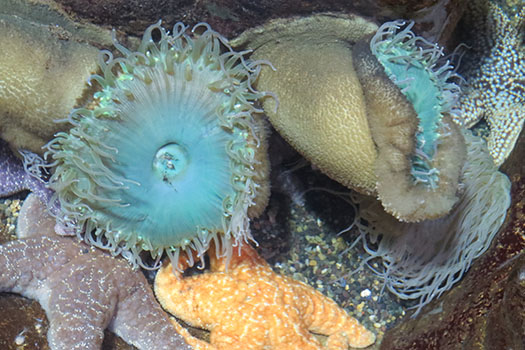Tidepools are one of the most volatile and harsh environments found on Earth. Life within these pools requires literally clinging on to one spot in order to resist waves constantly pulling and pushing against the ecosystem.

Sea stars and anemones are some of the residents of the harsh tidepool environment. Tidepools abound along the California coast, and most are easily accessible to visitors. Photo courtesy of Aquarium of the Bay
By Mallory Johnson
Published: July, 2016
Tidepools are one of the most volatile and harsh environments found on Earth. Life within these pools requires literally clinging on to one spot in order to resist waves constantly pulling and pushing against the ecosystem. Life in a tidepool isn’t easy, and only specialized animals and plants can survive. Despite the harsh conditions, life thrives here—from colorful sea stars and spongy sea cucumbers to vibrant sea anemones.
Sea Cucumbers: Sea cucumbers are a force to be reckoned with. They can effectively ensnare or confuse their predators by spewing out their sticky insides. Sea cucumbers are for the most part detrivores, meaning they extract nutrients from animal excrement, algae and other sorts of waste. Sea cucumbers are very important to tidepools because they keep them fresh by cleaning the bottom floor of organic materials, recycling nutrients, oxygenating the top layers of the sea floor, and preventing the buildup of toxic materials.
Sea Hares: While sea hares themselves eat algae, they are also a common food source for predators such as the spiny lobster. In order to defend themselves against predators, sea hares will squirt an opaline and purple inky substance. This mixture covers the predator’s antennae or smelling apparatus. Once covered, the predator has to clean its nose in order to continue its attack, giving the sea hare a chance to escape.
Sea Anemones: There are more than 1,000 species of sea anemones in the world that come in all colors and sizes. These unassuming anemones are typically soft and squishy, but protect themselves with stinging tentacles that pack a bite. Anemones typically attach themselves to rocks on the sea bottom while waiting for fish to pass by. Prey that swim close enough can find themselves ensnared in their venomous tentacles.
Sea Stars: Within the tidepool ecosystem, sea stars are a top predator and a keystone species. This means they are so important to the ecosystem that if they were removed, the entire ecosystem would change drastically. They help maintain tidepool populations by preying on mussels and most barnacles, keeping these rapidly growing species from taking over an entire tidepool. Sea stars are strong enough to pry open a mussel’s shell, despite having few muscles themselves. They have thousands of tiny tubed feet that they alternate between suctioning, releasing, and moving to pry open the shells. All they need is 0.1 mm of space to invade the mussel’s shell by inserting its stomach and digesting the mussel, all from within the shell.
The California coast is an excellent place to experience tidepools and the amazing wildlife found within them. Tidepools abound in California, and most are easily accessible to visitors who want to learn more about the magnificent flora and fauna living here.
Another great place to learn all about tidepools and the life within them is at Aquarium of the Bay, where guests are welcome to visit the California Tidepool touchpool and learn about these animals from naturalists or during daily presentations such as tidepool feedings. Guests can also learn more about how we can help protect tidepool animals from threats caused by climate change and other human activities by checking out daily presentations, science experiments, and dissections in our Bay Lab. To find out more about the tidepools at Aquarium of the Bay, visit www.aquariumofthebay.org.
Mallory Johnson is the Communications Manager at Aquarium of the Bay, a nonprofit dedicated to protecting, restoring and inspiring the conservation of San Francisco Bay and its watershed.

